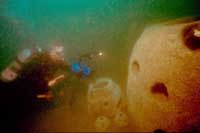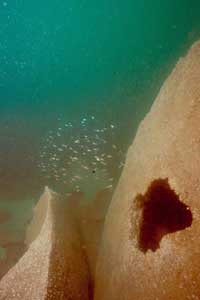

Story last updated at 11:49 p.m. on Tuesday, July 11, 2000
Then the 500 balls of concrete came. And when Hughes and fellow divers Alex Waters and Ed Kalakauskis finned their way over the new artificial reef recently, silvery schools of fish swam around the concrete 50 feet down and barnacles were attached to the pock-marked surfaces. In the months ahead, about 500 more concrete balls will be dropped on what is called the Charles H. Kirbo Memorial Reef, named for an Atlanta attorney involved in the preservation of the natural environment. And researchers, including Mandarin High School students, will continue to see the concrete transform into a living reef, ultimately stretching from off St. Augustine to Jacksonville Beach. "It is like seeing an empty field, then coming back three weeks later and there are condos," said Waters, coordinator of the $85,000 project. "Within the first few weeks you will get a base coat of barnacles and small organisms, then schools of bait fish and bottom-dwelling fish," Hughes said. "Within a year, it will be hard to recognize they [the concrete balls] are man-made." In 1993, Bradenton diver Todd Barber invented Reef Balls -- hollow, gumdrop-shaped concrete balls filled with holes to lure fish, plants and crustaceans to underwater sites. Since then, his company, Reef Ball Development Group, has helped make 100,000 balls ranging from 35 pounds to a 2-ton ''Ultra Ball" used in more than 200 artificial reef projects worldwide. The Kirbo memorial reef will be the company's largest when all 1,000 balls are dropped between St. Augustine and Jacksonville in the next year. The project is a collaborative effort between Jacksonville University, St. Augustine and Mandarin high schools, Jacksonville's Offshore Sport Fishing Club and the reef research team. Dozens of divers and other volunteers worked with Reef Ball employees to mold balls in the past year in downtown Jacksonville. Waters' marine biology students made 15 more at Mandarin High and a dozen were done by St. Augustine High School students and dumped off St. Augustine Inlet June 3. Waters said six of his diving-certified students can't wait to check out their efforts on site in a few weeks.
"I know they [students] will be absolutely amazed," he said. "They are used to seeing them on the ground at school -- inert concrete that is not alive, not looking at something covered with coral and sponges with fish swimming in and out. Seeing that transformation, it will be well worth the effort to see the expressions on their faces." Hughes said he and other divers plan to go back next week to map the balls' positions. The next batch of balls should be dropped this fall. |

